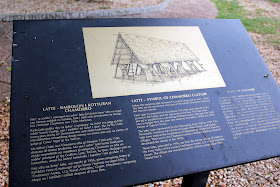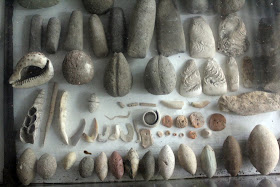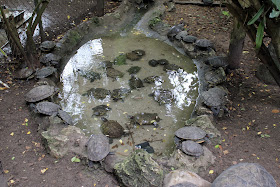 I've been on Guam now for a week...it feels like much longer. Days are so much slower when there's nothing to do but sit on the beach! (Although Im finally almost done reading all the Harry Potter Books!)
I've been on Guam now for a week...it feels like much longer. Days are so much slower when there's nothing to do but sit on the beach! (Although Im finally almost done reading all the Harry Potter Books!)We actually did do a lot of touristy stuff this week, which was fun. Underwater World is a pretty cool aquarium just down from our hotel. You walk through the whole thing in a clear tube that meanders through the huge tank that has sharks, fish, coral, anemone, sea turtles, etc.
 This little guy was so cute!
This little guy was so cute! Lionfish
Lionfish Giant Spider Crab. EEk...would not want to run across one of those in the water. It was like 3 feet long. YUK.
Giant Spider Crab. EEk...would not want to run across one of those in the water. It was like 3 feet long. YUK.


 We also went to see Guam's statue of liberty.
We also went to see Guam's statue of liberty. 
"The San Antonio or Stone Bridge was built over the Hagatna River in 1800 by the Spanish Governor Manuel Muro and dedicated to San Antonio de Padua. It spanned the Agana Canal between the pre World War II districts of San Ignacio and Bilibic. The bridge is a good example of the Spanish stone construction of the 19th century. The coconut tree lined Hagatna River flowed parallel to the ocean and offered a picturesque setting where people strolled past wading caribao [local animal like a water buffalo], splashing children, and women washing the family clothes along the riverbank.
The bridge has survived floods, high surf and war. For 150 years the bridge welcomed lumbering caribao families in wooden carts, barefooted skipping children, strolling mestiza clad women, marching uniformed military men and the baker pulling his bread wagon. When the Americans rebuilt Hagatna after World War II, the river was diverted, creating a park around the war-damaged bridge. Over the years it has been partially restored.
The bridge has survived floods, high surf and war. For 150 years the bridge welcomed lumbering caribao families in wooden carts, barefooted skipping children, strolling mestiza clad women, marching uniformed military men and the baker pulling his bread wagon. When the Americans rebuilt Hagatna after World War II, the river was diverted, creating a park around the war-damaged bridge. Over the years it has been partially restored.
Similar stone bridges were part of the Camino Real, the important Spanish coastal road south of Umatac. The San Antonio Bridge is on the Guam and National Registers of Historic Places." I think they used coral limestone...thats what it looked like from the decaying part of the bridge here.
I think they used coral limestone...thats what it looked like from the decaying part of the bridge here.
 I think they used coral limestone...thats what it looked like from the decaying part of the bridge here.
I think they used coral limestone...thats what it looked like from the decaying part of the bridge here. "Guam's legendary mermaid, Sirena, lived in Agana during Spanish times near the Minondo River where fresh spring waters dividing the city of Agana met the ocean at the river's mouth (Bicana) not so far from the site of the statue above. She loved the water and was known to swim whenever she could steal a moment from her chores to satisfy her greatest pleasure.
"Guam's legendary mermaid, Sirena, lived in Agana during Spanish times near the Minondo River where fresh spring waters dividing the city of Agana met the ocean at the river's mouth (Bicana) not so far from the site of the statue above. She loved the water and was known to swim whenever she could steal a moment from her chores to satisfy her greatest pleasure.One fateful day, Sirena's mother sent her to get coconut shells to be used as coal for the iron. Oblivious to time and duty, Sirena couldn't resist the refreshing river. There she swam while her mother called impatiently. Sirena's godmother happened to be visiting, and as her mother angrily cursed her daughter with the words, "Since Sirena loves the water more than anything, she should become a fish", her Nina (godmother) quickly interjected, "leave the part of her that belongs to me".
Unknown to mother, godmother, family and friends, Sirena was never to return home again, for feeling unusual sensations as she swam, she soon discovered that from the waist down she had become part fish. Her mother, regretful of her curse, could not undo the outcome of fate. Bidding her loved ones farewell, Sirena swam out into the Pacific. Since her disappearance, seafarers have reported seeing her in different parts of the world. According to legend, she can only be caught with a net of human hair.
 We also went to Latte Stone Park, which is home to some latte stones (see below) and an extensive network of caves built under command of the Japanese in WWII.
We also went to Latte Stone Park, which is home to some latte stones (see below) and an extensive network of caves built under command of the Japanese in WWII.


 Latte Stone Park is named for the Latte Stones that currently reside there. "As early as 500 A.D. ancient Chamorros built their houses on stone pillars known as lattes. These pillars are notable for their two-piece construction; the supporting column (hala-gi) topped with a capstone (tasa). The Halagi was made from coral limestone and usually carried several miles from the quarry site for installation in the appropriate location. The tasa was made from natural, hemispherical coral heads collected from the reef. In Latte Park, eight of these stones are displayed. These lattes were transferred to their present location in Hagåtña from Me’pu, their original location in Guam’s southern interior."
Latte Stone Park is named for the Latte Stones that currently reside there. "As early as 500 A.D. ancient Chamorros built their houses on stone pillars known as lattes. These pillars are notable for their two-piece construction; the supporting column (hala-gi) topped with a capstone (tasa). The Halagi was made from coral limestone and usually carried several miles from the quarry site for installation in the appropriate location. The tasa was made from natural, hemispherical coral heads collected from the reef. In Latte Park, eight of these stones are displayed. These lattes were transferred to their present location in Hagåtña from Me’pu, their original location in Guam’s southern interior." We also went to the site of an old Spanish building, the Governor's Palace, from when the island was under Spanish control.
We also went to the site of an old Spanish building, the Governor's Palace, from when the island was under Spanish control.
 This little round house was called the Chocolate House, and was built for the Governors wife. Apparently it was the custom to serve hot chocolate in the afternoon, so this is where she would serve important guests hot chocolate. Im not sure why anyone would want to drink that here as it is so hot and humid, but I guess back then it was much more of an exotic delicacy than it is now!
This little round house was called the Chocolate House, and was built for the Governors wife. Apparently it was the custom to serve hot chocolate in the afternoon, so this is where she would serve important guests hot chocolate. Im not sure why anyone would want to drink that here as it is so hot and humid, but I guess back then it was much more of an exotic delicacy than it is now! I loved the old stone walls surrounding the complex.
I loved the old stone walls surrounding the complex. These huge trees were pretty awesome too. Apparently trees don't usually get very big here because of all the typhoons.
These huge trees were pretty awesome too. Apparently trees don't usually get very big here because of all the typhoons. I also went to the Guam Zoo. It was an interesting experience. They claimed to have a lot of local animals...but I actually think the majority were non-native.
I also went to the Guam Zoo. It was an interesting experience. They claimed to have a lot of local animals...but I actually think the majority were non-native.

 These fruit bats were huge, maybe 10 inches tall. And they smell like skunks.
These fruit bats were huge, maybe 10 inches tall. And they smell like skunks.

 I loved the collections of sea shells and stuff. I want to know what those pointed oblong stones are above.
I loved the collections of sea shells and stuff. I want to know what those pointed oblong stones are above. Check out that HUGE crab claw and scorpion. Ewww!
Check out that HUGE crab claw and scorpion. Ewww! This is a coconut crab. The worlds largest land crustacean. And, its claws are apparently so strong it can crush a whole coconut. Whoa.
This is a coconut crab. The worlds largest land crustacean. And, its claws are apparently so strong it can crush a whole coconut. Whoa. Some annoying geese that followed me around the whole zoo.
Some annoying geese that followed me around the whole zoo. They had a shark in a tiny little pond...it was kinda sad.
They had a shark in a tiny little pond...it was kinda sad. This llama was hilarious. Look at his face! Hilarious.
This llama was hilarious. Look at his face! Hilarious. They had a bajillion turtles. Thats right, a BAJILLION.
They had a bajillion turtles. Thats right, a BAJILLION. This is a Carabao. Its like a water buffalo.
This is a Carabao. Its like a water buffalo.

Oh, and check out the earthquake we got on Saturday night. 5.2! Scott and I argued for about 5 minutes about who was shaking the bed before we figured out what it was!

This is a map showing all the earthquakes Guam has had in the last 25 years. Hmmm.






"Days are so much slower when there's nothing to do but sit on the beach"
ReplyDeleteThat's it. I'm moving to Guam.
I'm drooling over that tree!!
ReplyDeleteGorgeous photos of everything.
Harry Potter is one of my and my son's favorite series ever. I love that the books get thicker and the storylines are more detailed and more serious as Harry gets older. And so many little things in later books tie back to the earlier books - great attention to detail.
The oblong stones might me lingam(s?) ... there was actually a cool jewelry show referencing them in Germany last year: http://www.konstfack.se/lingam/
ReplyDeleteHi! The oblong objects are sling stones and primarily used as weapons prior to the arrival of the Spanish over three hundred years ago.
ReplyDelete